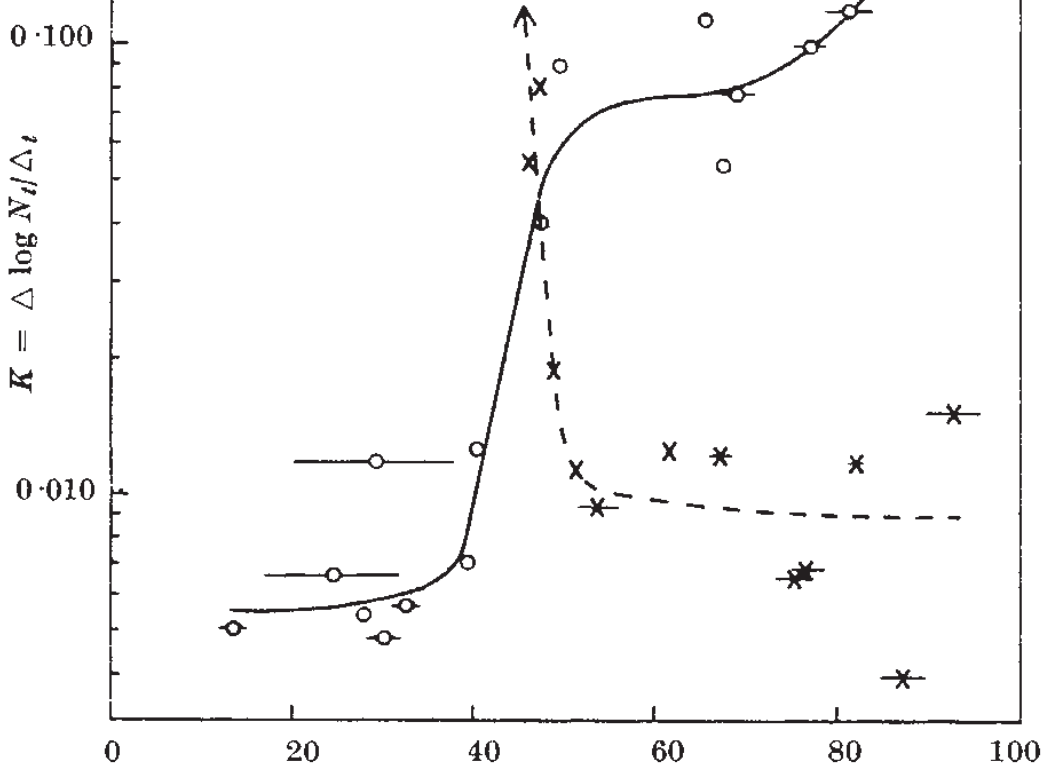Hemmes J. H., dkk. Kelangsungan Hidup Virus sebagai Faktor Musiman di Influenza dan Poliomyelitis, Nature 1960, 188: 430-431.
Percobaan telah menunjukkan bahwa virus influenza bertahan lebih lama di udara pada kelembaban rendah, dan virus polio - pada kelembaban tinggi. Hal ini sesuai dengan aktivitas influenza yang diamati di musim dingin dan aktivitas polio di musim panas. Grafik pertama dalam artikel menunjukkan tingkat inaktivasi (kematian) virus influenza (\ (\ circ \)) dan poliomyelitis (\ (\ times \)) pada skala logaritmik, bergantung pada kelembaban relatif (dalam persen):

Harper G. J. Mikro-organisme di udara: uji kelangsungan hidup dengan empat virus, Epidemiologi & Infeksi, 1961, 59 (4): 479-486.
, , . . , — . , 64% 24 °C, — 3–4%.
Akers T. G., et al. Airborne stability of simian virus 40 ( SV40 ), Applied microbiology, 1973, 26(2):146–148.
, SV40 ( ). 21 °C ( 22% 88%). 32 °C (50–60%) .
Sohaffer F. L., et al. Survival of Airborne Influenza Virus: Effects of Propagating Host, Relative Humidity, and Composition of Spray Fluids ( : , ), Archives of Virology, 1976, 51(4):263–273.
, , , . , , .
Chew F. T., et al. Seasonal trends of viral respiratory tract infections in the tropics ( ), Epidemiology & Infection, 1998, 121(1):121–128.
1990 1994. - (), . (–) ( , –). , ́ . , . .
Lowen A. C., et al. Influenza Virus Transmission Is Dependent on Relative Humidity and Temperature ( ), PLoS Pathogens, 2007, 3(10):1470–1476.
, ( ) . 20 . 8 :

, , , , 5 °C, 20 °C. 30 °C .
20 °C 20%, 35%, 50%, 65% 80%. 20% 35% ( 3–4 4). 50% . 65% 3 4 , 80% — .
5 °C 50% 80% , 20 °C , .
. -, , . , , 3 . -, ( ). -, , ́ .
Lowen A. C., et al. High Temperature (30 °C) Blocks Aerosol but Not Contact Transmission of Influenza Virus ( (30 °C) , ), Journal of virology, 2008, 82(11):5650–5652.
, , 30 °C 20%, 50%, 65% 80%. .
Shaman J., et al. Absolute humidity modulates influenza survival, transmission, and seasonality ( , ), PNAS, 2009, 106(9):3243–3248
, , . , . , .
, . , . (\(p=0,048\) \(p=0,059\) ), (\(p=0,00027\)).
Shaman J., et al. Absolute Humidity and the Seasonal Onset of Influenza in the Continental United States ( ), PLoS Biology, 2010, 8(2):e1000316.
. , . , .
: , , , — , , , , .
Noti J. D. et al. High Humidity Leads to Loss of Infectious Influenza Virus from Simulated Coughs ( ), PLOS ONE, 2013, 8(2):e57485.
.
, . 4 , . 40% .
Kudo E., et al. Low ambient humidity impairs barrier function and innate resistance against influenza infection ( ), PNAS, 2019, 116(22):10905–10910.
, ( ), , .
Yueling Ma, et al. Effects of temperature variation and humidity on the death of COVID-19 in Wuhan, China ( -19 ), Science of the Total Environment, 2020, 724:138226.
-19 20 29 2020 . () -19:

Yu Wu, et al. Effects of temperature and humidity on the daily new cases and new deaths of COVID-19 in 166 countries ( -19 166 .), The Science of the total environment, 2020, 729:139051.
, . 1 °C 3.08%, 1.19%. 1 — 0,85% 0,51% .
Sajadi M. M., et al. Temperature, Humidity, and Latitude Analysis to Estimate Potential Spread and Seasonality of Coronavirus Disease 2019 (COVID-19) ( , -19), JAMA Network Open, 2020, 3(6):e2011834.
50 10 2020 . 8 -19 42 , -19. , 10 -19 10 2020 .
8 ( , , ́ , , , , , ) 30 ° 40 ° , : 5–11 °C, 4–7 \(\text{/}^3\).
, -19 .
Günther Th., et al. Investigation of a superspreading event preceding the largest meat processing plant-related SARS-Coronavirus 2 outbreak in Germany ( , -19 ), Social Science Research Network, 2020-07-23.
Grafik, pengaturan spasial pekerja, kondisi iklim dan ventilasi, transportasi dan kondisi kehidupan dianalisis, analisis lengkap genom virus dilakukan. Diketahui bahwa penularan infeksi terjadi di ruang tertutup di mana udara terus-menerus diedarkan dan didinginkan hingga 10 ° C. Penularan virus di antara karyawan dilakukan dalam tiga hari kerja, dimulai dengan salah satunya. Virus itu ditularkan melalui jarak lebih dari 8 meter. Semua karyawan diharuskan memakai masker dan menjaga jarak.